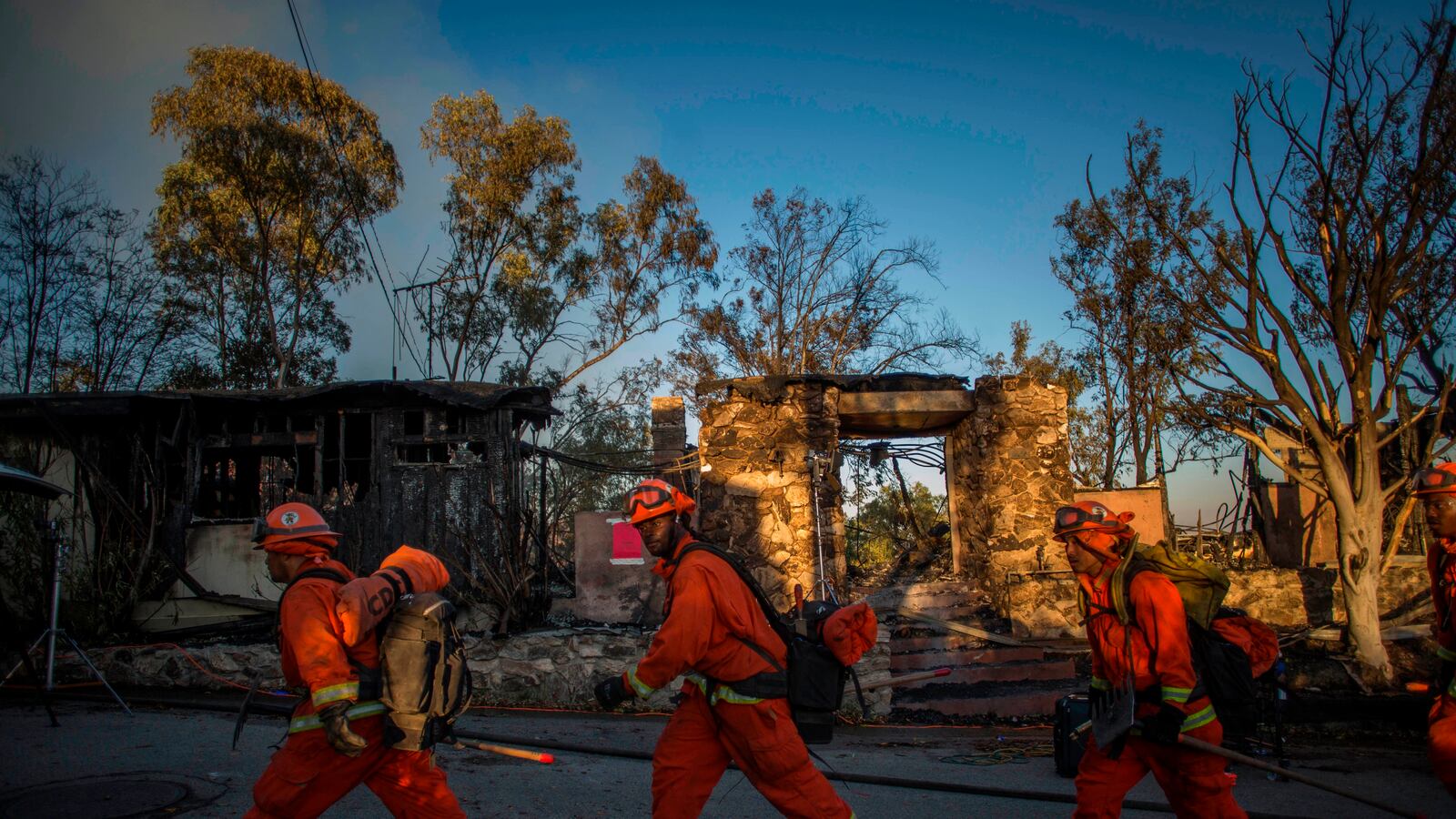Around 3:30 a.m. Monday, a tech company recruiter named Peter Locke woke up to a phone call. Locke is an older man with bushy white eyebrows, bushier sideburns, and a warm, low voice. He lives in the upper reaches of Mandeville Canyon, a long, narrow strip north of Los Angeles, east of Westridge Canyonback Wilderness Park, and right in the middle of a mandatory fire evacuation zone.
“I picked up the phone and my neighbor said, ‘Get your shit together,’” Locke recalled. “He said, ‘And do it in five minutes. There’s an evacuation order.’ I just grabbed whatever I could: the backup for my computer, a cellphone, a few dollars, some papers, my wallet, that’s it. I barely had time to put on clothes. It was early Monday morning—the middle of the night.”
Just hours before Locke’s call, a strong wind had knocked a tree branch into a powerline, sparking a fire along the 405 Freeway near the Getty Center, the renowned art and architecture museum overlooking Los Angeles. The blaze spread quickly, burning hundreds of acres within hours, and requiring evacuations around wealthy neighborhoods like Brentwood and Pacific Palisades.
Along with roughly 10,000 of his neighbors, Locke fled the area that morning. He headed seven miles south to the Westwood Recreation Center, a sprawling complex situated at the center of a West Los Angeles park. By rec-center standards, the Westwood facility has posh amenities: a pool, a playground, a tennis court, a soccer field, two gymnasiums, indoor racquetball courts, outdoor basketball courts, and the original baseball diamond that inspired The Bad News Bears. It does not, however, have beds. Still, within the span of a few hours, Locke saw the place converted from neighborhood sports center to active evacuation shelter. Volunteers unfolded cots in the gym. Neighbors brought food to the dining hall. Thousands streamed in and out, chatting, drinking coffee, ushering animals into the rooms designated for pets.
In a press conference Tuesday evening, Mayor Eric Garcetti confirmed the Getty Fire had burned more than 650 acres and was 15 percent contained. It’s one of several wildfires scorching the state. Hundreds of miles to the north, the Kincaid Fire has burned more than 75,000 acres of Sonoma’s Wine Country, closing schools, cutting power, and forcing almost 200,000 people from their homes. As of Tuesday, that blaze was also just 15 percent contained and authorities said it could burn for weeks.
Late Tuesday night, Locke sat in a chair in the lobby, his walker pushed to the side. The room had been divided into stations: a line of chairs under a giant fabric mural of a boat, a welcome desk staffed by the Red Cross, two folding tables piled with donated snacks, and a computer area, where two PCs were set to TV networks: one played the World Series, the other flickered with clips from fire coverage.
Locke was chatting with a woman named Kathleen Jensen, a volunteer who once lived in the evacuation zone. Jensen had arrived at the rec center the day before to see if anyone needed help. She had met a shy older woman with back problems, who was scared to stay over. Jensen wound up spending the night, tending to the woman, comforting and befriending her. By Tuesday, both Jensen and Locke had spent two days just talking to evacuees and reporters. There had been so many different kinds of people, they said, even some famous ones. Mayor Garcetti came to talk; Gov. Gavin Newsom’s wife swung by.
“Lester Holt came!” Locke remembered.
“Lester Holt?” Jensen asked, her face lighting up. “Oh, I just love Lester Holt. You know Lester Holt, right? From NBC? Oh, he’s just the best.”
“I said to him,” he continued, “Lester, I love you. The only thing I don’t like is you’re always badmouthing my boy, Trump.”
“Oh,” Jensen sighed. “Did you say that? Well, I love Lester Holt.”
“He’s the best guy on TV,” Locke agreed. “I met a lot of people–dozens of people, interesting people. I’ve never heard more namedropping than today. Everybody knows somebody famous. One guy knew Steve McQueen. He knew Marlon Brando. He told me Marlon Brando was gay, but I already read that. That shocked me when I found out. Brando’s gay? Who knew!”
When asked why he heard so much namedropping, Locke paused. “I guess it’s just when you get talking to people. My wife died about a year ago, and I work at home. I talk to people on the phone. But here, I’ve just been sitting talking to people for two days. This one guy was telling me crazy crap. Like, he was one of the top karate experts in the United States. And he said, ‘I’ve got a 100-pound wolf. I use it as a dog.’ And I said, ‘That guy’s nuts.’ But then he came back with a damn wolf.”
After some small talk, Jensen announced she was going home. The woman she’d been caring for had found friends. And besides, the shelter numbers were dwindling. People were going to friends’ houses or hotels. But Locke hadn’t heard much about his home.
“They keep telling you the same thing: ‘We don’t know,’ ‘We can’t say,’” he said, without resentment. “It’s kind of dormant now, but this huge Santa Ana wind is coming in tonight. It’s gonna last all night—until 8 in the morning. After that, it may be OK. But nobody knows. They’re all telling you something different. You just can’t tell. And I can’t phone any of my neighbors either cause they’ve all split.”
The wind in question was a major event, forecast to begin around 11 p.m. Tuesday night, peaking at 3 a.m., and lasting until 8 a.m. Wednesday morning. The gusts were predicted to hit hurricane-like speeds––as high as 80 miles per hour in some areas––so high, the National Weather Service issued their first ever “extreme” red flag warning for the region.
Betsey Landis, a former electrical engineer and another guest at the Westwood Rec Center (whom Locke described as “the smartest person here”), said the winds could bode well or very badly. “If the wind blows against the fire, which gives the firemen more chance to smother it all, then we’re in good shape,” Landis said, “But if it blows from the north to the west, we could have some more serious problems.”
Landis has lived in Mandeville Canyon for 50 years. “I live at the top,” she said. “That’s five miles up.” She had fled much like Locke: in the middle of Monday night, after a series of increasingly alarming phone calls. Landis is a stately woman, with blue eyes, shoulder-length gray hair, and a brown cane. She dressed like someone in the Audubon Society: earth-tone slacks, green jacket, a colorful handkerchief tied at the neck, a brown fedora with bird feathers in the brim.
“I evacuated just once before,” Landis said, “but it wasn’t a true evacuation. There was a house fire, but it was started by a couple guys smoking marijuana cigarettes in the backyard and throwing them over the fence. It rolled up the hillside behind me, and this police helicopter hung out with a very loud horn, going GET OUT RIGHT NOW GET OUT GET OUT. So, I got out. But I just went over to UCLA. My two neighbors both work at UCLA, so I just went with them.”
This time felt more real, Landis said. Her home wasn’t in danger, as far as she knew. But the fire alarms, the escape route, the shelter—it was all weightier and better executed than some cop screaming from a chopper. “This is my first time to see the whole process,” she said. “You hear all these things about what happens when people have to go to some kind of evacuation center. I’ve really enjoyed sitting here watching who comes through the doors when, what happens here, how fast the Red Cross and people have come to help. I’ve learned just how uncomfortable it is to lie on a steel frame cot in the gym.”





